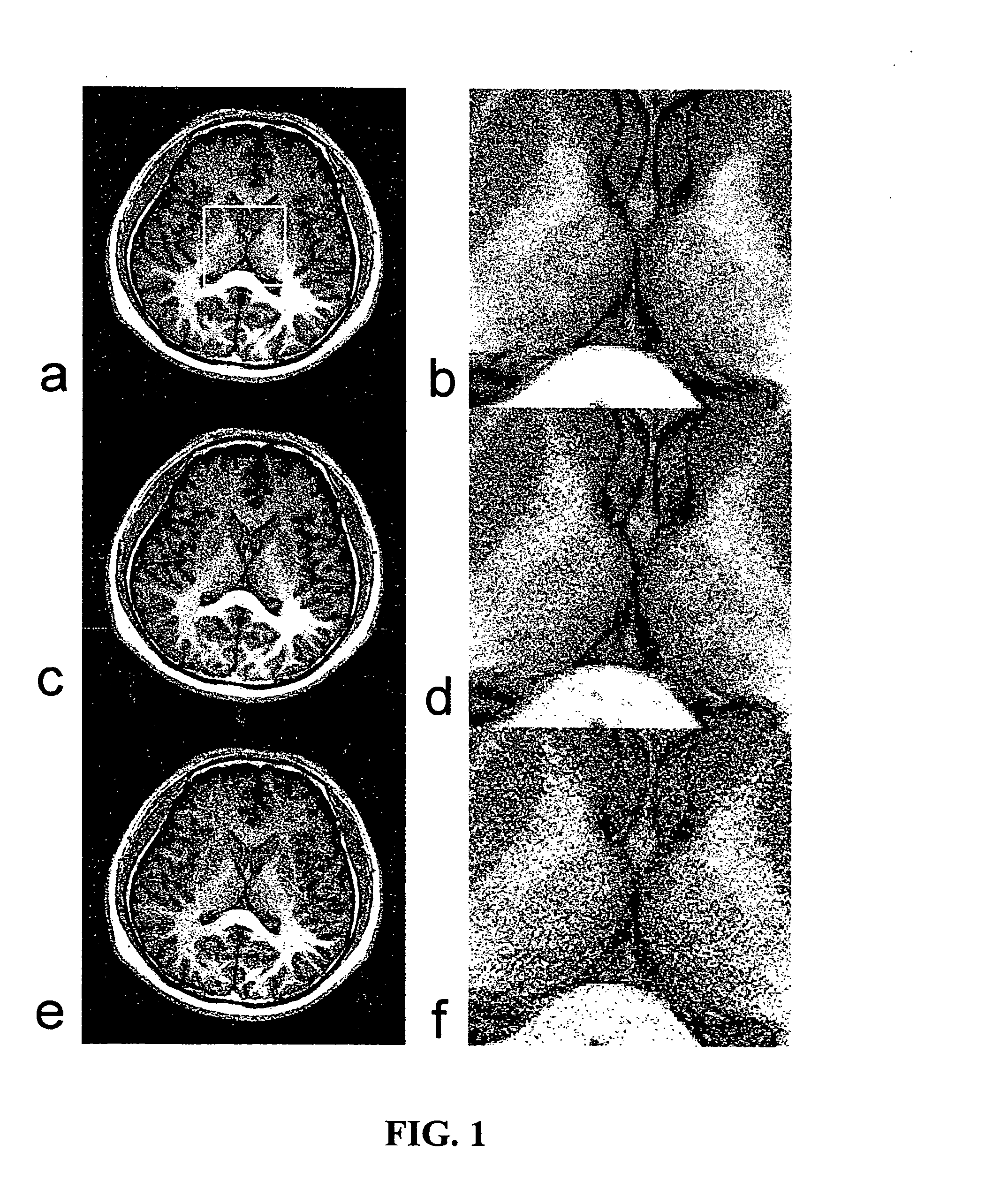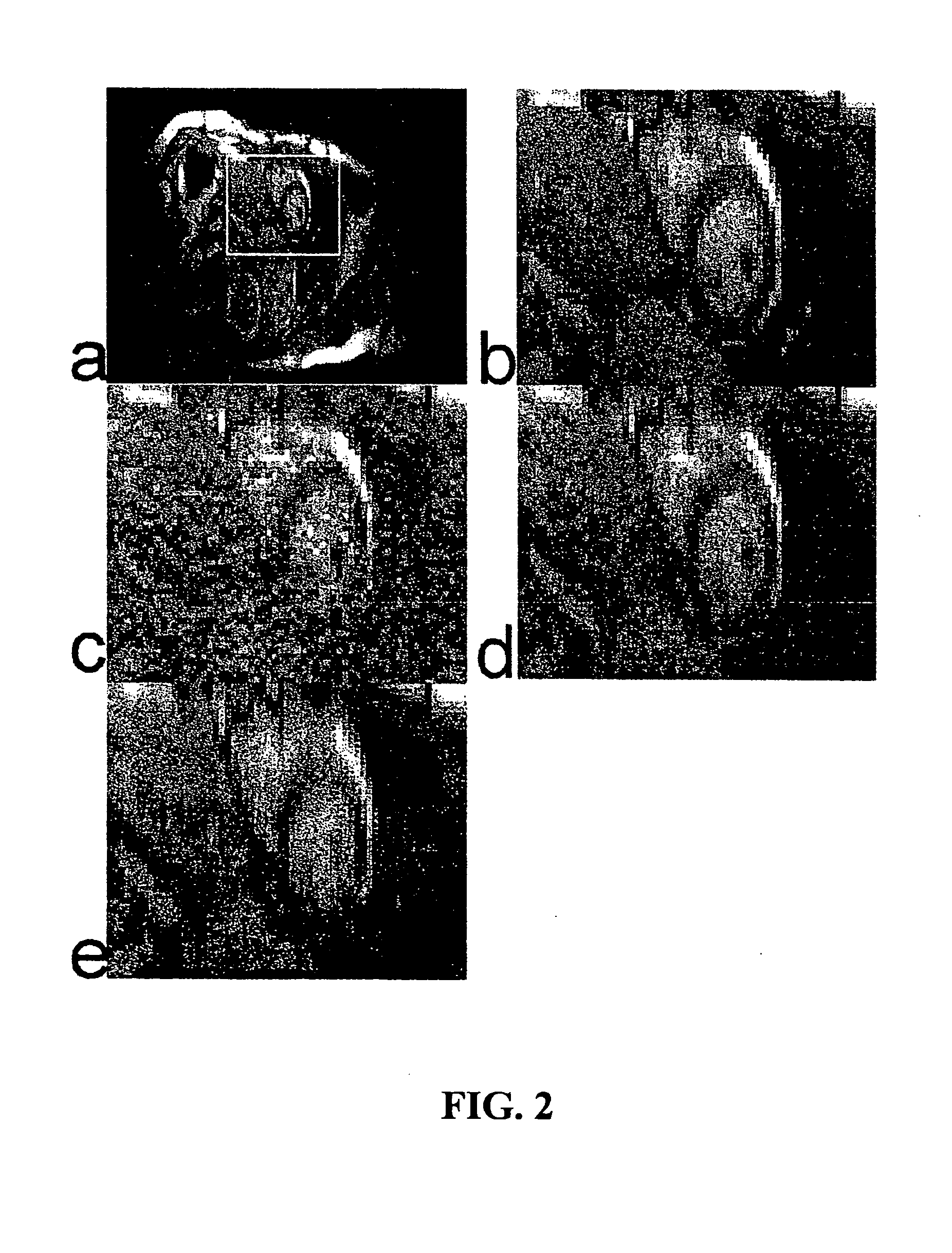Method and Apparatus for Parameter Free Regularized Partially Parallel Imaging Using Magnetic Resonance Imaging
a technology of magnetic resonance imaging and parameter free, applied in the field of parameter free regularized partially parallel imaging using magnetic resonance imaging, can solve problems such as resolution loss, and achieve the effects of reducing error, reducing snr, and reducing spatial resolution
- Summary
- Abstract
- Description
- Claims
- Application Information
AI Technical Summary
Benefits of technology
Problems solved by technology
Method used
Image
Examples
examples
[0049]To compare GRAPPA and hp-GRAPPA. high-resolution axial brain anatomy data were collected on a 3T GE system (GE Healthcare, Waukesha, Wis., USA) using the Ti FLAIR sequence (FOV 220 mm, matrix size 512×512, TR 3060 ms, TE 126 ms, flip angle 90°, Slice thickness 5 mm, number of averages 1) with an 8-channel head coil (Invivo Corporation, Gainesville, Fla., USA). PE direction was anterior-posterior.
[0050]To demonstrate the performance of embodiments of the subject method with good g-factor, one additional data set is used. This data set is for oblique cardiac images, collected on a SIEMENS Avanto system (FOV 340×255 mm, matrix 192×150, TR 20.02 ms, TE 1.43 ms, flip angle 46°, slice thickness 6 mm, number of averages 1) using a cine true FISP sequence with a 32-channel cardiac coil (Invivo Corp, Gainesville, Fla.). There are 12 images per heartbeat and the PE direction is also anterior-posterior. Because more elements are available and there are elements on both th...
example set 1
bp-GRAPPA
[0058]In this example, hp-GRAPPA was applied to brain images. FIG. 1 shows the results of an axial slice acquired with an 8-channel coil. The acceleration factor was 4, with 56 ACS lines; the net reduction factor was 3. FIG. 1A shows the reference image. The right columns show the zoomed-in version of the region identified by the white boxes in FIG. 1A. The results of GRAPPA (FIGS. 1E and 1F) depict excess noise. The errors in the results of hp-GRAPPA (FIGS. 1C and 1D) are moderate. The relative errors were reduced from 13% (axial) to 9% (axial). From the zoomed images, it is observed that the definition of boundaries and visibility of some structures are seriously damaged by noise in images reconstructed by conventional GRAPPA, but the damage is clearly reduced in the images reconstructed by hp-GRAPPA. Moreover, the spatial resolution was not reduced because of the regularization.
example set 2
db-GRAPPA with Ideal Regularization Information
[0059]FIG. 2 and Table 1 show the comparison of several reconstruction algorithms when there is no mis-registration between prior information and the target image. The SNR of image reconstructed by the regularization algorithms with optimized parameter (FIG. 2E) is higher than those by the parameter free technique (FIG. 2D); however, this gain is achieved with a significant loss of spatial resolution. The result of db-GRAPPA (FIG. 2D) has almost identical spatial resolution as the result of GRAPPA (FIG. 2C) but has considerably less noise. With net reduction factor 3.3, db-GRAPPA can still generate images with reasonable quality. The relative errors shown in Table 1 again shows that db-GRAPPA can generate images with less relative errors than that by GRAPPA (reduced from 21.7% to 12.1% at ROI) and those by regularized methods with a carefully chosen parameter (reduced from 20.4% to 12.1% at ROI).
TABLE 1The relative errors of reconstruct...
PUM
 Login to View More
Login to View More Abstract
Description
Claims
Application Information
 Login to View More
Login to View More - R&D
- Intellectual Property
- Life Sciences
- Materials
- Tech Scout
- Unparalleled Data Quality
- Higher Quality Content
- 60% Fewer Hallucinations
Browse by: Latest US Patents, China's latest patents, Technical Efficacy Thesaurus, Application Domain, Technology Topic, Popular Technical Reports.
© 2025 PatSnap. All rights reserved.Legal|Privacy policy|Modern Slavery Act Transparency Statement|Sitemap|About US| Contact US: help@patsnap.com



